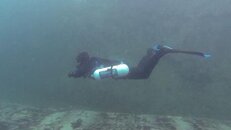So I recently completed my OW and have done a few dives. I'm really enjoying it and am keen on doing AOW some time in the future. I know you can technically go straight from OW to AOW, but are there any particular skills/techniques I should have absolutely bombproof first to maximise how much I get from the AOW course? Cheers.
If you have access to a 12 to 30 foot deep area where snorkeling could be fun, then this could be a phenomenal opportunity for you to make yourself a much better diver than any AOW course is going to make you....Two components sadly lacking in OW divers, as well as AOW divers, is the BUOYANCY/TRIM skills set, AND the OPTIMAL PROPULSION skill and fitness set...
With some freedive practice and enjoyment doing this, it is "natural" to learn to swim in optimal trim, horizontally, and with kick strokes that are very efficient to allow breath hold dives to get you some place. You have great bio-feedback.
Most scuba divers never learn to kick well, and this includes most of the Scubalab testers in the print magazines, and a large percentage of the dive instructors we see teaching at major Tourism destinations.
Well is sort of subjective...so lets compare to skiing.... most of the dive instructors have their skill sets down as well as the intermediate skiiers do with their techniques on green and blue slopes--they might even look pretty on these easy slopes.......But there is little thought about ever learning the skills that could get them to being good at skiing double diamond slopes, or extremes. Mediocre is what MOST Dive instructors settle for, and the excuse is that diving is not about going fast in the water.
The reality is that having the skill and fitness to go very fast in the water, also translates perfectly to having the skill and fitness to do an entire dive at a heart rate at 50 to 75 beats per minute ( or lower)--to be amazingly good on air consumption because your kicking does not waste energy....and doing this at speeds that most divers consider a normal cruising pace....
This will involve learning the many types of kick shapes you can use to essentially change gears underwater, how to be efficient at each, and how to chose the fins best for yourself when you have these skills and base fitness for underwater propulsion. Again, freediving takes you to the next level for this, much more effectively than scuba will.
Once you gain these skills from freediving, then transferring these skills to scuba makes all the AOW to GUE Fundies type courses, all the easier for you to master.
My perspective is that Diving is partially about "Getting somewhere" underwater...Whether you have to jump off a boat, or walk out from a beach...you have to swim someplace to get where the sights or photos you desire, are going to be found. Good diving IS about getting somewhere...You want to get there by wasting the least amount of air possible...and if you are limited to an hour per dive( as on many boats), you want to get to this desired place fairly soon, so you can enjoy most of your dive at this desired place....In the event of a gear failure or underwater emergency, getting someplace could be getting to the surface, without lift from the BC, or it could be getting to an anchor line against a strong current...your ability to "get someplace" really well....with great efficiency and power or speed if needed, could someday save your life, or that of a buddy....
Sometimes there is this "desired place" , everywhere around you, from the moment you jump in. That's great, apparently you won't need too many propulsion skills when you don't need to swim anywhere. this is what the current training paradigm seems to be about to me, in this world where there is no emphasis on optimizing fin swimming skills, or figuring out which fins really are best for you.
DISCLAIMER***While I say Industry in this discussion, it should be obvious that there are INDIVIDUAL INSTRUCTORS that take great pains to teach good kicking skills, and good trim & buoyancy skills.
Find one of the great instructors, and you are going to end up with pretty much everything you need. But....just like with medical doctors, or with attorneys, MOST Instructors are very mediocre or worse.
To find the really good ones, you practically need to know someone that already KNOWS a great one....and that knows what great is, versus average is.
If a dive shop has one of the great instructors--this is a huge BRAGGING POINT, and the advertising the shop does for it's instruction, should play up this amazing Instructor and what he or she can do for you....Conversely, if the shop is advertising Groupon classes, the big selling point is CHEAP INSTRUCTION...If they had a really great instructor--the instructor you really WANT....they should not want to give away something this RARE and hard to find, at 50% off or more. What you really want, the best...should never be expected to be a "loss leader"...
Many new divers will have no good idea about how to find a good instructor....first they will often need to get plugged into a network of divers like scubaboard....a great place to look for friends that can give valuable recommendations---a place where you don't have to compare one ad to another....
And, you can mitigate this problem by getting some freediving instruction, and then enjoying freediving on your own time--as this will evolve your SCUBA skills and be fun at the same time.





